How to change DNS to surf faster, speed up Internet
Changing DNS on Windows has many benefits, such as: Accessing some blocked websites, speeding up internet connection, improving network stability. Changing DNS is changing the way computers use Domain Name System (DNS), the basic technology for all web browsers today. It is also a fast and free way to speed up the Internet. Here's how to change DNS on Windows 10, Windows 7 and other Windows versions. The last part of the article, Network Administrator is going to talk a little bit about why changing DNS helps speed up the internet.
If you are not sure about DNS, how does DNS work, do not ignore the article about DNS on TipsMake.com.
Before proceeding to change DNS, select a DNS you want to change. Refer to the best DNS list on TipsMake.com to choose a DNS you like.
Video tutorial on how to change DNS on Windows
Change DNS with OpenDNS
This is the simplest way to change DNS to speed up the browser: Free use, DNS servers run extremely fast with OpenDNS service instead of using the ISP's DNS server. OpenDNS has a huge DNS hosting site, with many DNS servers scattered around the world. So, it is possible to find an IP address that helps you get online faster than the ISP's DNS servers.
OpenDNS server addresses are 208.67.222.222 (primary DNS server) and 208.67.220.220 (secondary DNS server). To use OpenDNS servers, you will have to change a bit in computer settings.
Change DNS on Windows 7, Windows 8 / 8.1 and Windows 10
If you are using Windows 7, Windows 8, 8.1 or Windows 10 operating system, follow the steps below:
Step 1: Go to Control Pannel> Network and Sharing Center or right-click on the network icon in the system tray, select Open Network and Sharing Center .

Step 2: Click Change Adapter settings on the left (the second line from the top).
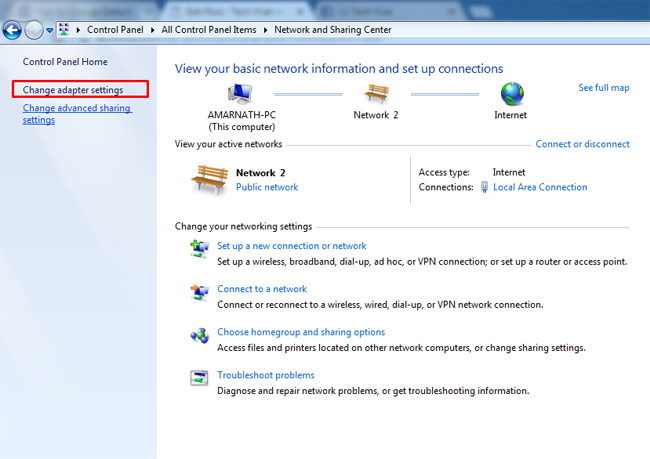
Step 3: Select the Internet connection currently in use, right-click and select Properties .
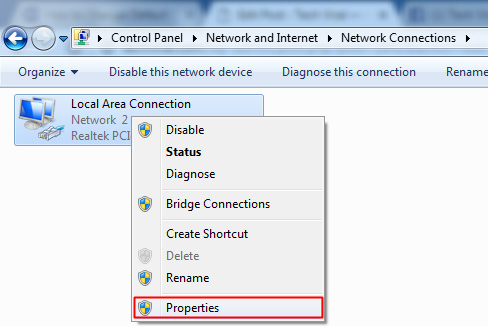
Step 4:
Click Internet Protocol Version 4 (TCP / IPv4)> Properties> Gerneral> Use the following DNS server addresses:
- Preferred DNS server: 208.67.222.222
- Alternate DNS server: 208.67.220.220
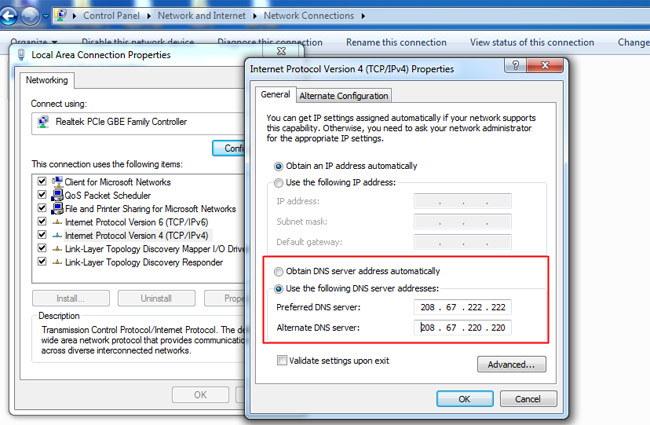
Click OK to finish selecting the DNS server address to speed up the Internet.
Step 5: Perform IPv6 configuration, in the Ethernet 2 Properties window, select Internet Protocol Version 6 (TCP / IPv6)> Properties> Gerneral> Use the following DNS server addresses:
- Preferred DNS server: 2620: 0: ccc :: 2
- Alternate DNS server: 2620: 0: ccd :: 2
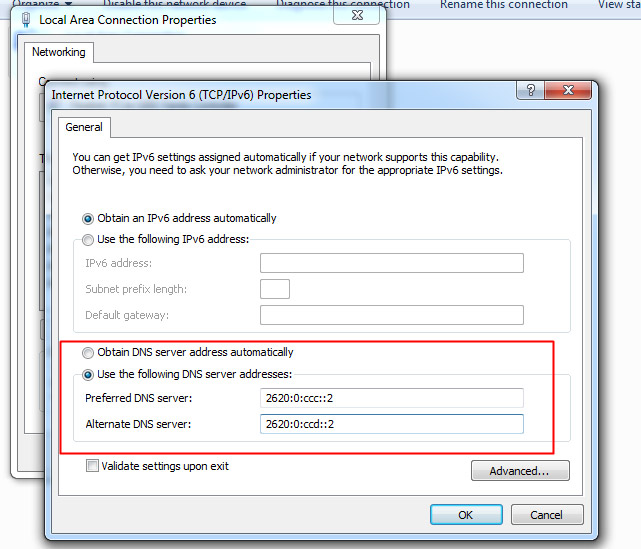
Click OK to save the changes.
Step 6: Save all settings and now you are using a DNS with faster surfing capabilities. Thanks to this DNS Internet speed has been greatly improved.
Change DNS on Windows XP
If you're using Windows XP, first select Control Panel -> Network and Internet Connections -> Network Connections , right-click the network connection in the Network Connections window, select Properties . The dialog box shown below appears

Select Internet Protocol (TCP / IP) and click Properties
In the scrolling list, select Internet Protocol (TCP / IP) and click Properties . In the lower part of the new window that appears, select " Use the following DNS server addresses ". At the Preferred DNS server enter the address 208.67.222.222. At the Alternative DNS server section enter the address 208.67.220.220 (below picture). Click OK , click Close and Close again to close all windows. Restart the computer for the settings to take effect.
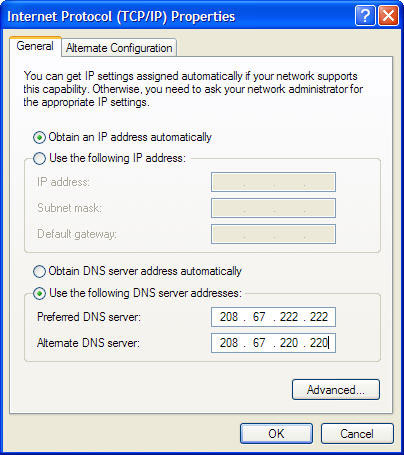
Enter the address to tell the computer that you use the OpenDNS server
How to change DNS Windows Vista
If using Windows Vista, select Control Panel -> Network and Internet -> Network and Sharing Center . Click on the View Status link on the right part of the screen. The Local Connection Status screen appears as shown below, click Properties
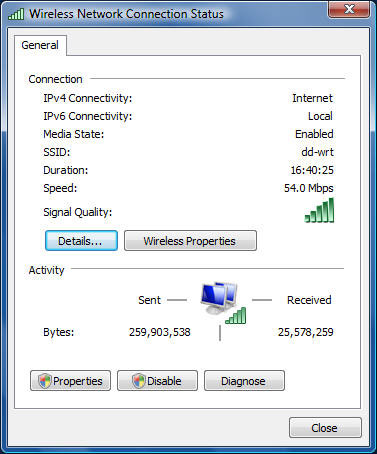
Click Properties to set up using OpenDNS
You will see a dialog similar to the one in Windows XP to set up using OpenDNS server.
Change DNS for the entire computer network to OpenDNS
When configuring a machine using OpenDNS, only that machine can use OpenDNS server. If you want all computers on your network to work, you must configure the router to use the OpenDNS server. Following this router configuration, you will not have to configure each individual PC.
There are a number of ways you can change the router and it will depend on the router you configured to be used at home, in a small office or in a large company. For small and home office routers, you will have to access the router, find the DNS settings section and then use the OpenDNS 208.67.222.222 setup for the main DNS server and 208.67.220.220 for the DNS server. session
Whether you run a small network or a large network, you can benefit from being faster than DNS. In addition, the service also gives you some DNS management tools such as domain block, statistics and network graph usage.
On the Linksys SRX 400 router and many other Linksys routers, access to the router must be through 192.168.1.1, use the administrator as a password and leave the username blank. In the login page, scroll down to the Static DNS 1, Static DNS 2 section and change it (as shown below), click Save Settings. Restart the router and the network computer, your entire computer will then use OpenDNS DNS server.
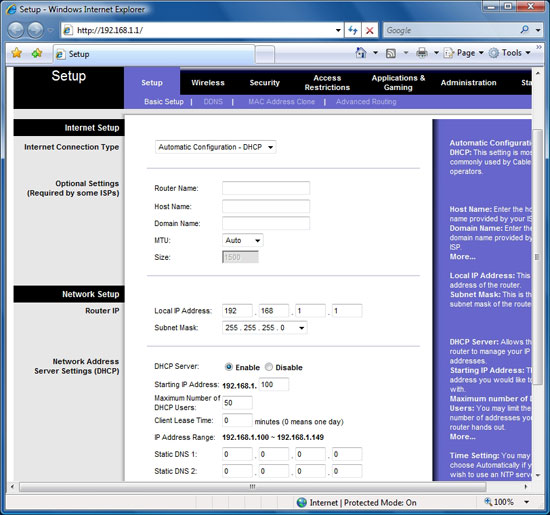
Change DNS settings in this window to use
OpenDNS server for the entire network
Note that OpenDNS may not work when using a virtual private network (For example, I cannot be the one when using Cisco VPN). And if you're on a corporate network, you should check with your system administrator before using OpenDNS.
OpenDNS also allows you to create shortcuts to access your favorite pages just by typing a word or group of words instead of having to enter the URL. To do this, you must first register (of course free), then go to the OpenDNS website, access the registered account, click on link Shortcuts. On the page that appears, enter the short name of the website in the box above and the URL in the box below; then click Create Shortcut. From now on, you can quickly access the website that has placed the shortcut by entering the short name of the website in the browser window address and then press Enter, the entire website URL will be filled out.
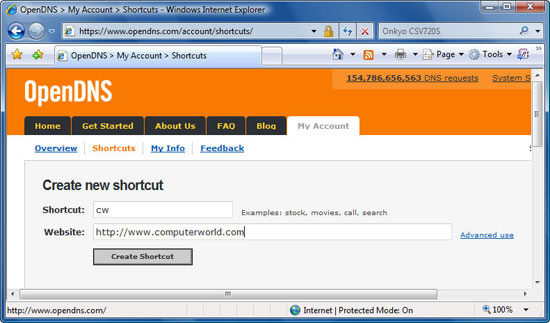
Create shortcut in OpenDNS
Change the default DNS to Google DNS to speed up the Internet
This method is very simple, you can change the default DNS extremely easily and will be transferred to higher-speed DNS, speed up file downloading and web browsing. Follow the steps below!
Step 1: Go to Control Panel> Network and Sharing Center , or right-click the network icon in the system tray and select Open Network and Sharing Center .
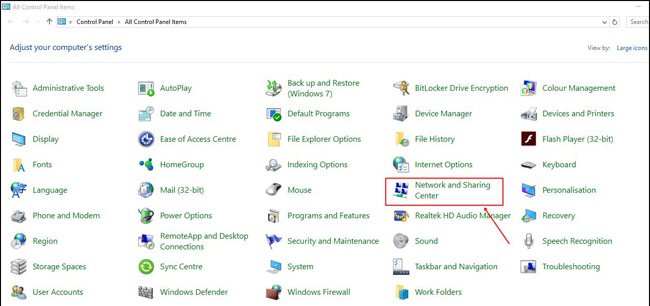
Step 2: Click Change adapter settings on the left.
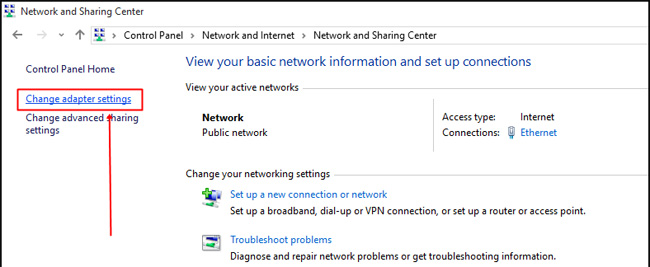
Step 3: You are seeing all of your computer's networks, choose the network you want to configure to use Google's DNS, then right-click on the network icon and select Properties .
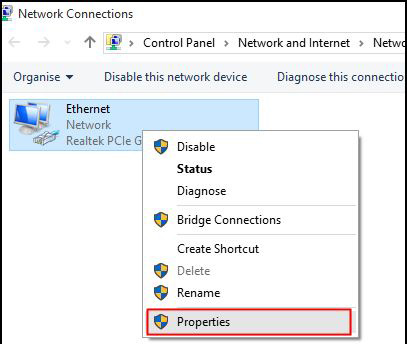
Step 4: In the N etworking tab > This connection uses the following items> Internet Protocol Version 4 (TCP / IPv4)> Properties.
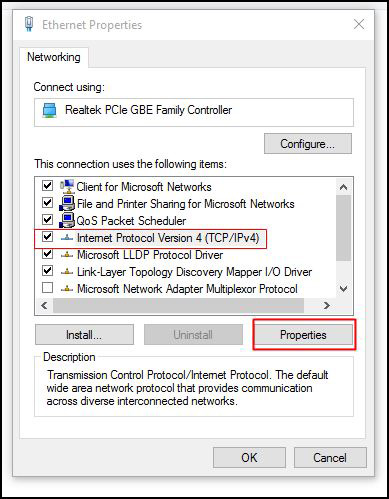
Step 5: In the General tab select Use the following DNS server addresses:, if there is a default IP there, just delete them, fill in the Google DNS value of 8.8.8.8 or 8.8.4.4 , click OK and start network again.
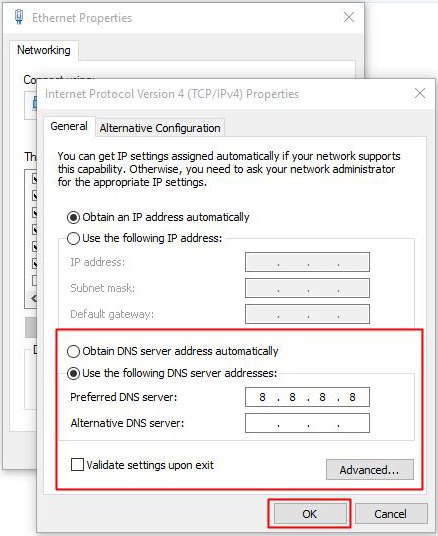
Change DNS with DNS Jumper
This is an application that helps to change DNS servers quickly. Just download DNS Jumper, install it on the computer, you will see a list of DNS servers like Google Public DNS, Open DNS, Yandex and more, select a favorite server and click Apply DNS .

With DNS Jumper you can switch to DNS server to access the network faster with just a few clicks instead of having to perform manual DNS change steps.
Speed up access with HOSTS file
This is another way to speed up DNS - by creating and editing HOSTS files on your own computer. This file contains URL addresses (also known as hostnames) and exchange IP addresses. Windows will first look up the address you need in this file to see if it is the entry point of the hostname, if it finds it in the list, it will decide to use that address. Therefore, you will not be able to exit the DNS server and must wait for a response before you can visit the website.
HOSTS file is just a plain text file that can be created or edited through a simple editor like Notepad. You will find the current HOSTS file in C: WindowsSystem32DriversEtcHOSTS for both Windows XP and Windows Vista (in some other versions, you can find it at C: WinntSystem32DriversHOSTS ). This file has no extension; Its name is just HOSTS. If you can't find any such file, you can create it directly with Notepad.
Open the HOSTS file with Notepad, enter the IP address and hostname of the websites you normally visit, eg 65.182.110.189 quantrimangcom .
Each entry point in the file must be on one line. The IP address must be on the first column and the corresponding hostname on the next column. Minimize each other by a space between two columns. When you have finished editing the file, save it before exiting.
Make sure to check the HOSTS file regularly and keep it up to date, otherwise you may be denied access to some websites. For example, if the website www.quantrimang.com changes its IP address but your HOSTS file still retains the old IP address, the address is incorrect and your browser will not be able to find the website.
Adjust DNS storage (DNS cache) of Windows
To speed up DNS, Windows will place DNS information in the DNS cache of your computer when you visit the site. So when you want to go to a website, Windows will first search the DNS cache, call the cache, see where the DNS information contains them. Therefore, if it finds information on the local machine, it will not find in the HOSTS file or query to the remote DNS server to find IP information. Cache is created by recently queried names and entries are taken from HOSTS file.
The cache contains both the rejected entry point and the authenticated entry point. The entry point for authentication is that DNS search points are successful and you can connect to the website. When Windows searches in the cache, if it finds an entry point, it will immediately use that DNS information and send it to the requested website.
Denied entries are found in inappropriate points and you get the error message ' Cannot find server or DNS ' in the browser. Similarly, when Windows searches in the cache and finds the entry point rejected, it returns an error message that does not continue searching the site.
Denied entry points may be the cause of the problem. When you try to make a connection to the website that has been notified of the entry denied in the cache, you will only receive an error message, even if the website's problems have been fixed and it is currently available. can enter.
You can solve this problem by modifying the Registry. By default, Windows stores entries that have been rejected within 5 minutes. After 5 minutes, they will be automatically deleted in your cache.
But if you don't want that, you can force Windows to not save these points and you'll never encounter this problem. Open the Registry Editor by entering Regedit in a command prompt or in Vista, enter the search box and press Enter . Then go to the section:
HKEY_LOCAL_MACHINESYSTEMCurrentControlSetServicesDnscacheParameters
Create a new DWORD value with the name NegativeCacheTime and set it to 0 (This value may be available from the beginning, otherwise change it to 0)
This new DWORD defines the time (in seconds) to retain the rejected entry point in DNS cache. If you wish, you can retain the activity of entry points within a second by setting the value to 1.
After you've finished editing, exit the Registry. To make the change take effect, you must restart the computer or delete the existing cache on the computer by using the command ipconfig / flushdns in the command window. The command will erase your entire DNS cache (both the authenticated entry and the entry point are rejected) and it will start saving your website later. However, rejected entries will not be stored in the cache if you set the DWORD value to 0.
You can also use the Registry to control the total time the authenticated entry is kept in the cache. By default, they are retained for 24 hours. To change this default, go to Registry Editor, go to:
HKEY_LOCAL_MACHINESYSTEMCurrentControlSetServicesDnscacheParameters
You create the DWORD value named MaxCacheEntryTtlLimit (If it already exists, you just need to edit the value, no need to create a new one). Enter the Value of that DWORD equal to the time (in seconds) you want to save the entry point (make sure you use the basic decimal number).
Why changing DNS can help speed up the Internet?
DNS servers exist on the Internet and your computer relates to them with requests for compilation and domain name resolution. When using a network service provider (ISP), your computer will automatically use the ISP's default DNS servers; You may not need DNS settings. If your computer is on a corporate network, the company's system administrator can set up your computer to use specific DNS servers.
If there is a delay in contacting the DNS server, or if the DNS server takes too long to resolve the address, you will have to wait to get to the web. Even if you have the fastest connection in the world, your web surfing process may be slowed down.
If you can increase the time to resolve domain names, your surfing process may increase. And that's exactly what I want you to watch and follow the situations below.
To know if the DNS connection to the site has problems, you must first use the ping command to check for a website that is not connected:
ping quantrimang.com
If the website exists, you will be returned the following result (Note: Data may be different for each website):
If the website does not encounter errors, you will receive the following message:
Xin yêu cầu không tìm thấy máy phục vụ.
Hãy kiểm tra tên và thử lại.
That's something about DNS, now you probably want to know how to change DNS to speed up web surfing, right? Please refer to some of the ways below.
Above are some methods for DNS to speed up Internet access. By following these simple guidelines, you can easily speed up web browsing, download files and get a better Internet experience.
Don't forget to share this article if you find it useful as well as a comment below to comment!
You should read it
- Fake IP by VPN Gate access blocked website, stable network
- Google DNS - How to change Google DNS 8.8.8.8 8.8.4.4 to access the network faster and not blocked
- DNS Jumper - Change DNS very fast, extremely easy to access Facebook, speed up the network
- How to change DNS on iPhone, Android phones
- Instructions for changing Google DNS 8.8.8.8 8.8.4.4
- Speed up Internet access on Windows
- DNS Singapore - How to change DNS Singapore to access the network faster and not blocked
- How to change DNS on Windows 10
May be interested
- 7 free Windows password recovery tools
 the main function of the password recovery tool is to recover the passwords that users or administrators use when logging in to windows. these tools are often known as 'password stealing' tools because sometimes they are used by hackers to 'crack' user passwords.
the main function of the password recovery tool is to recover the passwords that users or administrators use when logging in to windows. these tools are often known as 'password stealing' tools because sometimes they are used by hackers to 'crack' user passwords. - How to use Folder Guard to set a folder password
 folder guard is a directory password software, which helps users secure their computer folders, but the folders are not hidden.
folder guard is a directory password software, which helps users secure their computer folders, but the folders are not hidden. - Compare Internet speed of DNS 1.1.1.1 with other popular DNS
 cloudflare announced the new dns service 1.1.1.1 on april fool's day (1/4). however, the service is real and the company claims it is the fastest dns service and privacy protection for users with a query speed that can be reached to a remarkable number, 14.01 ms.
cloudflare announced the new dns service 1.1.1.1 on april fool's day (1/4). however, the service is real and the company claims it is the fastest dns service and privacy protection for users with a query speed that can be reached to a remarkable number, 14.01 ms. - How to enable Core isolation protection on Windows 10 April 2018
 core isolation is a new protection feature in windows defender windows 10 april 2018. this feature will help your computer to be more secure.
core isolation is a new protection feature in windows defender windows 10 april 2018. this feature will help your computer to be more secure. - 7 security tips you can learn from the movie The Avengers
 avengers: earth's mightiest heroes is a movie you can learn a lot from superheroes. iron man teaches us to recognize the consequences of the action we do. vision character shows that in all of us there is compassion. let's find out what these heroes can teach us about technology, security and privacy!
avengers: earth's mightiest heroes is a movie you can learn a lot from superheroes. iron man teaches us to recognize the consequences of the action we do. vision character shows that in all of us there is compassion. let's find out what these heroes can teach us about technology, security and privacy! - Top 20 best encryption software for Windows
 in a pc, many of your personal information may be accessed illegally. that's because windows data is stored on the drive that is not encrypted or protected by encryption software so anyone can access your private and confidential information.
in a pc, many of your personal information may be accessed illegally. that's because windows data is stored on the drive that is not encrypted or protected by encryption software so anyone can access your private and confidential information.







 How to change DNS on Windows 11/10/8/7 and macOS to surf the web and speed up the network
How to change DNS on Windows 11/10/8/7 and macOS to surf the web and speed up the network 5 great ways to increase the speed of 3G Internet
5 great ways to increase the speed of 3G Internet Cloudflare's new DNS 1.1.1.1 service, more secure, faster web surfing
Cloudflare's new DNS 1.1.1.1 service, more secure, faster web surfing Internet acceleration 20% faster in Windows
Internet acceleration 20% faster in Windows Surf the web via SMS, without an Internet connection
Surf the web via SMS, without an Internet connection